Financial Analysis of Event Hospitality and Entertainment Limited
VerifiedAdded on 2021/06/15
|10
|2263
|32
Report
AI Summary
This report provides a detailed financial analysis of Event Hospitality and Entertainment Limited, an ASX-listed company operating in the hospitality and entertainment sectors across Australia, New Zealand, and Germany. The analysis covers a four-year period from 2014 to 2017, utilizing trend analysis of the income statement, vertical analysis of both the income statement and balance sheet, and ratio analysis to assess the company's financial performance and position. The report highlights the increasing revenue and expenses over the period, while also noting a decrease in net profit in 2017. The analysis includes details of the company's operations through various sectors, including Entertainment Australia, New Zealand, and Germany, as well as hotels, resorts, and property investments. Key financial metrics such as return on equity, return on assets, net profit margin, current ratio, and quick ratio are evaluated to determine the company's profitability and liquidity. The report concludes with an assessment of the company's financial stability and performance trends.
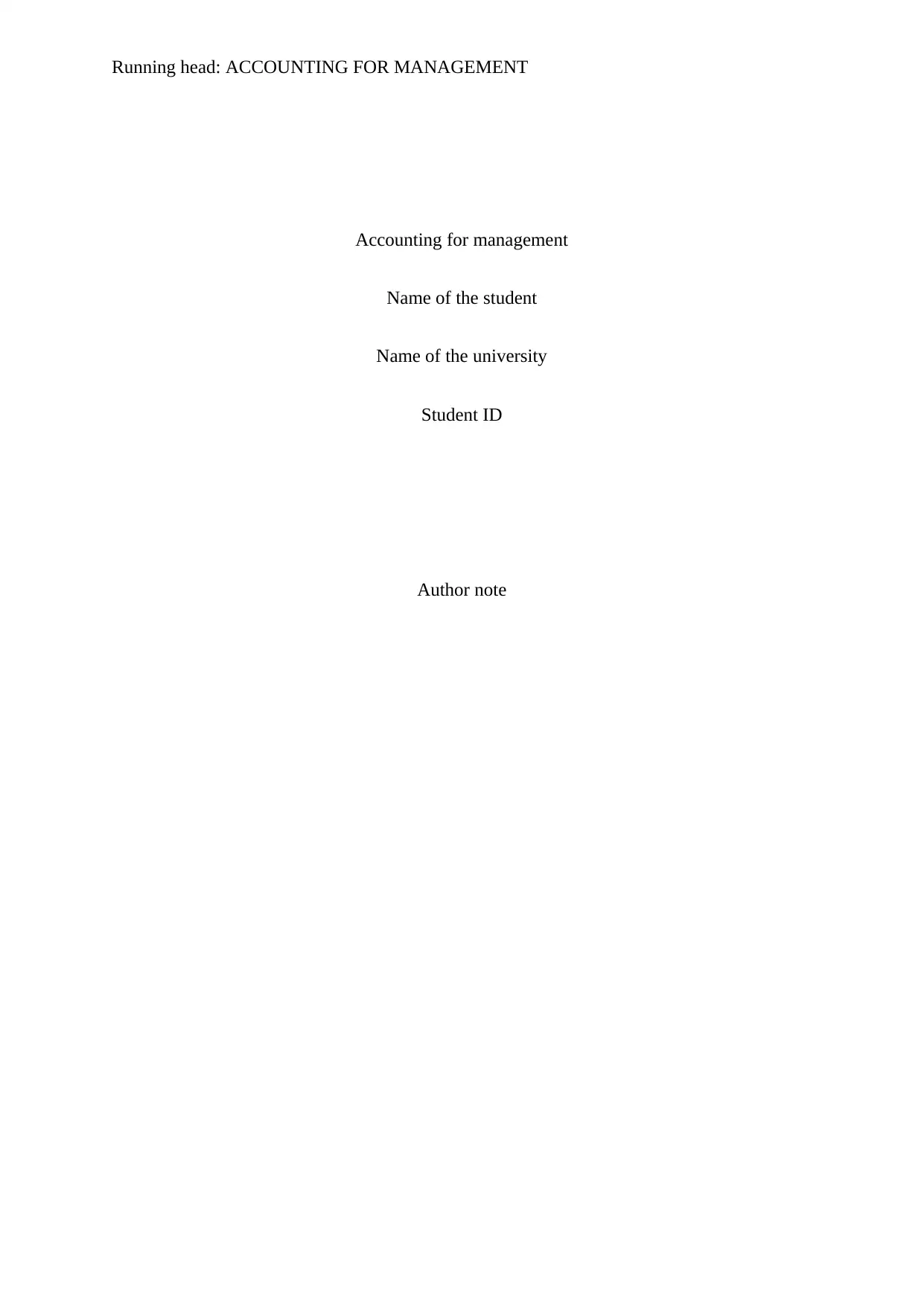
Running head: ACCOUNTING FOR MANAGEMENT
Accounting for management
Name of the student
Name of the university
Student ID
Author note
Accounting for management
Name of the student
Name of the university
Student ID
Author note
Paraphrase This Document
Need a fresh take? Get an instant paraphrase of this document with our AI Paraphraser
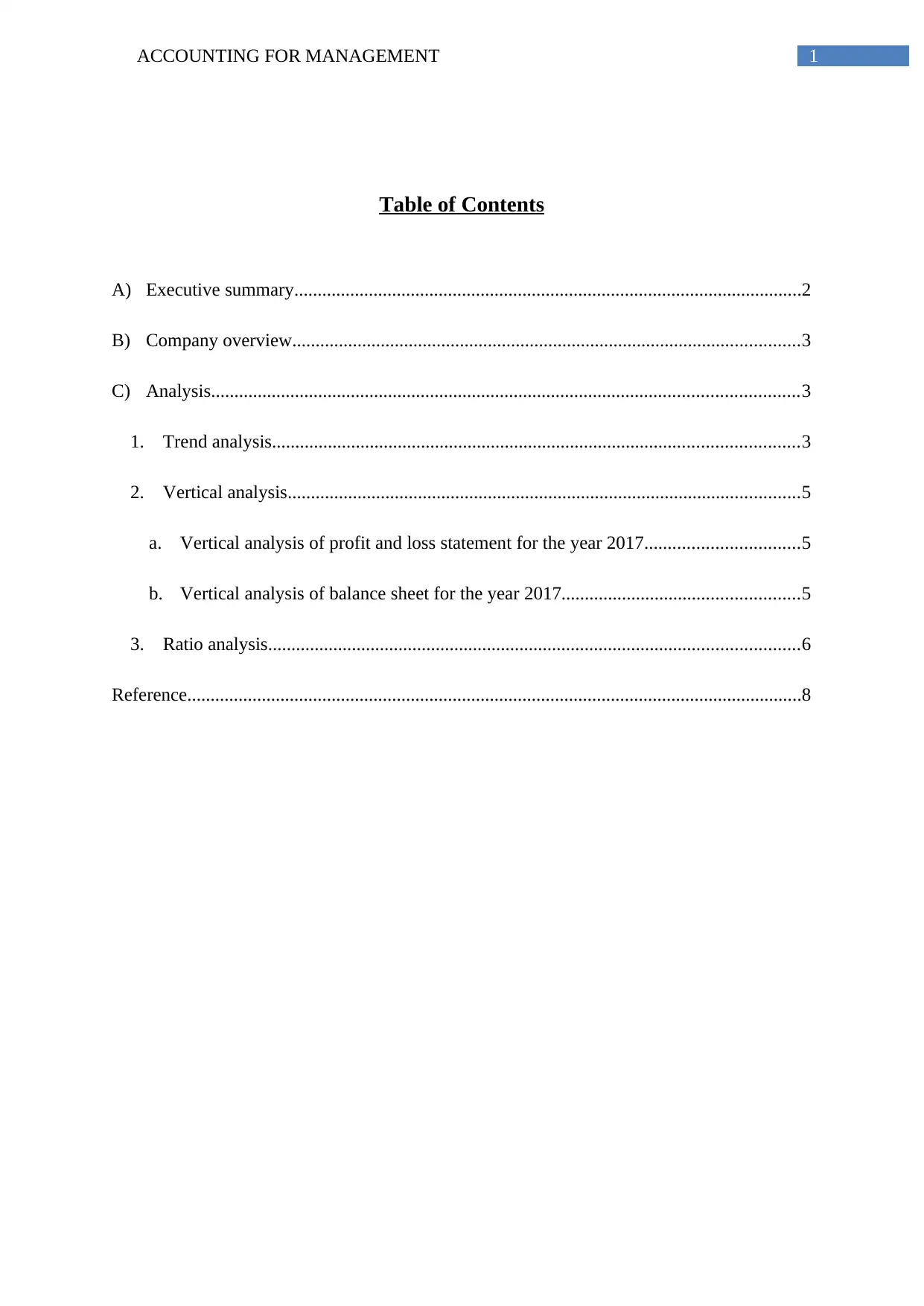
1ACCOUNTING FOR MANAGEMENT
Table of Contents
A) Executive summary.............................................................................................................2
B) Company overview.............................................................................................................3
C) Analysis..............................................................................................................................3
1. Trend analysis.................................................................................................................3
2. Vertical analysis..............................................................................................................5
a. Vertical analysis of profit and loss statement for the year 2017.................................5
b. Vertical analysis of balance sheet for the year 2017...................................................5
3. Ratio analysis..................................................................................................................6
Reference....................................................................................................................................8
Table of Contents
A) Executive summary.............................................................................................................2
B) Company overview.............................................................................................................3
C) Analysis..............................................................................................................................3
1. Trend analysis.................................................................................................................3
2. Vertical analysis..............................................................................................................5
a. Vertical analysis of profit and loss statement for the year 2017.................................5
b. Vertical analysis of balance sheet for the year 2017...................................................5
3. Ratio analysis..................................................................................................................6
Reference....................................................................................................................................8
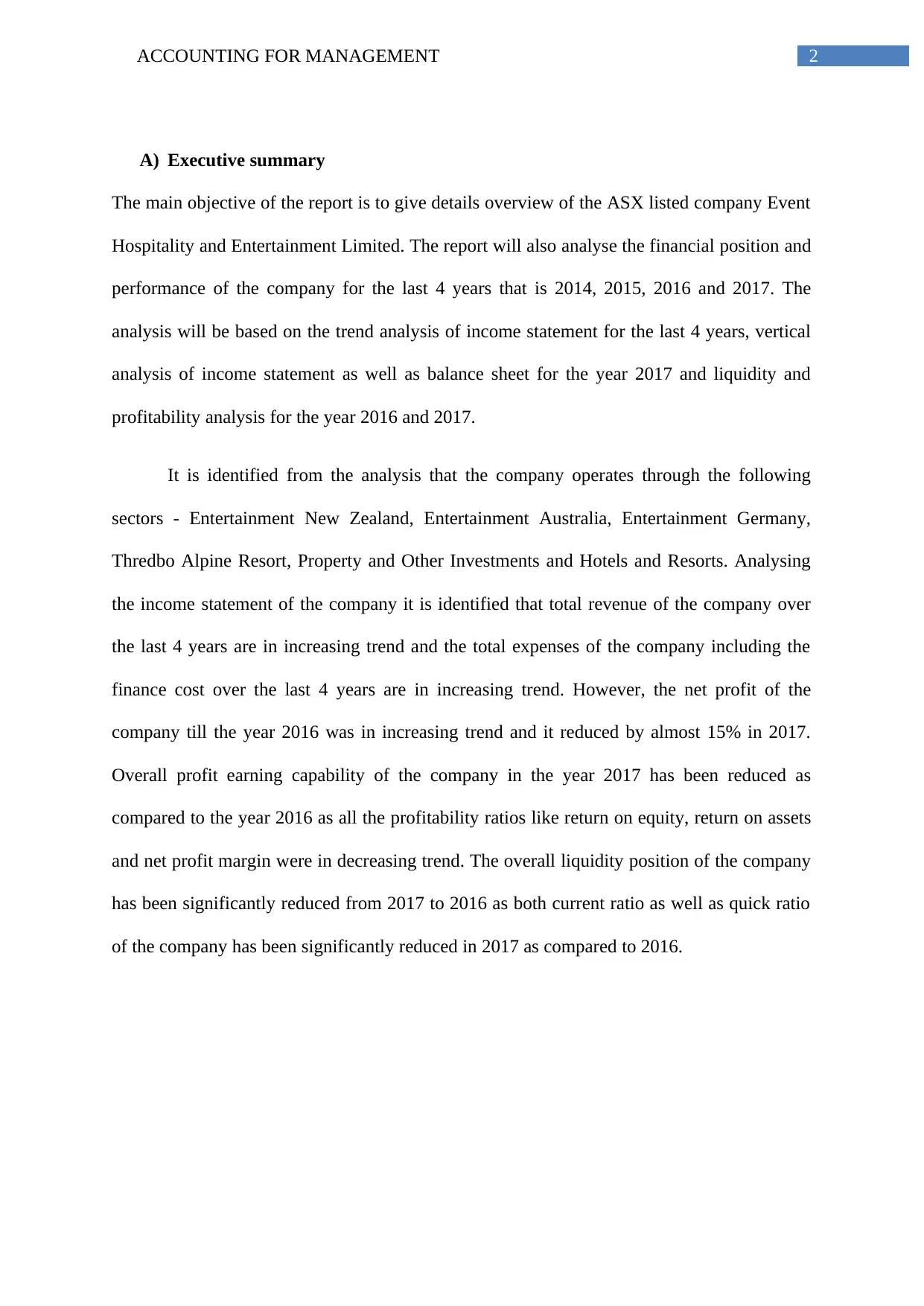
2ACCOUNTING FOR MANAGEMENT
A) Executive summary
The main objective of the report is to give details overview of the ASX listed company Event
Hospitality and Entertainment Limited. The report will also analyse the financial position and
performance of the company for the last 4 years that is 2014, 2015, 2016 and 2017. The
analysis will be based on the trend analysis of income statement for the last 4 years, vertical
analysis of income statement as well as balance sheet for the year 2017 and liquidity and
profitability analysis for the year 2016 and 2017.
It is identified from the analysis that the company operates through the following
sectors - Entertainment New Zealand, Entertainment Australia, Entertainment Germany,
Thredbo Alpine Resort, Property and Other Investments and Hotels and Resorts. Analysing
the income statement of the company it is identified that total revenue of the company over
the last 4 years are in increasing trend and the total expenses of the company including the
finance cost over the last 4 years are in increasing trend. However, the net profit of the
company till the year 2016 was in increasing trend and it reduced by almost 15% in 2017.
Overall profit earning capability of the company in the year 2017 has been reduced as
compared to the year 2016 as all the profitability ratios like return on equity, return on assets
and net profit margin were in decreasing trend. The overall liquidity position of the company
has been significantly reduced from 2017 to 2016 as both current ratio as well as quick ratio
of the company has been significantly reduced in 2017 as compared to 2016.
A) Executive summary
The main objective of the report is to give details overview of the ASX listed company Event
Hospitality and Entertainment Limited. The report will also analyse the financial position and
performance of the company for the last 4 years that is 2014, 2015, 2016 and 2017. The
analysis will be based on the trend analysis of income statement for the last 4 years, vertical
analysis of income statement as well as balance sheet for the year 2017 and liquidity and
profitability analysis for the year 2016 and 2017.
It is identified from the analysis that the company operates through the following
sectors - Entertainment New Zealand, Entertainment Australia, Entertainment Germany,
Thredbo Alpine Resort, Property and Other Investments and Hotels and Resorts. Analysing
the income statement of the company it is identified that total revenue of the company over
the last 4 years are in increasing trend and the total expenses of the company including the
finance cost over the last 4 years are in increasing trend. However, the net profit of the
company till the year 2016 was in increasing trend and it reduced by almost 15% in 2017.
Overall profit earning capability of the company in the year 2017 has been reduced as
compared to the year 2016 as all the profitability ratios like return on equity, return on assets
and net profit margin were in decreasing trend. The overall liquidity position of the company
has been significantly reduced from 2017 to 2016 as both current ratio as well as quick ratio
of the company has been significantly reduced in 2017 as compared to 2016.
⊘ This is a preview!⊘
Do you want full access?
Subscribe today to unlock all pages.

Trusted by 1+ million students worldwide
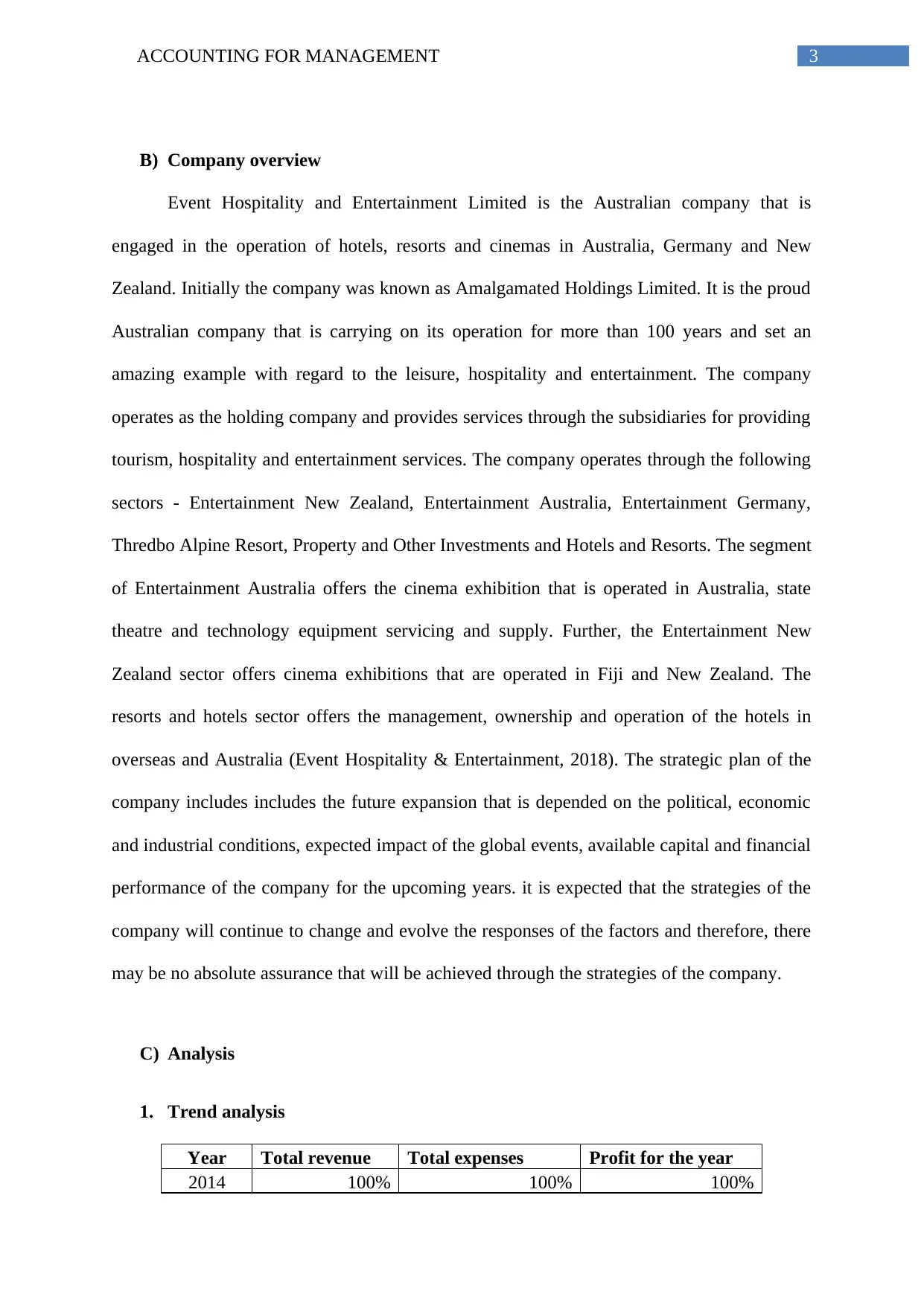
3ACCOUNTING FOR MANAGEMENT
B) Company overview
Event Hospitality and Entertainment Limited is the Australian company that is
engaged in the operation of hotels, resorts and cinemas in Australia, Germany and New
Zealand. Initially the company was known as Amalgamated Holdings Limited. It is the proud
Australian company that is carrying on its operation for more than 100 years and set an
amazing example with regard to the leisure, hospitality and entertainment. The company
operates as the holding company and provides services through the subsidiaries for providing
tourism, hospitality and entertainment services. The company operates through the following
sectors - Entertainment New Zealand, Entertainment Australia, Entertainment Germany,
Thredbo Alpine Resort, Property and Other Investments and Hotels and Resorts. The segment
of Entertainment Australia offers the cinema exhibition that is operated in Australia, state
theatre and technology equipment servicing and supply. Further, the Entertainment New
Zealand sector offers cinema exhibitions that are operated in Fiji and New Zealand. The
resorts and hotels sector offers the management, ownership and operation of the hotels in
overseas and Australia (Event Hospitality & Entertainment, 2018). The strategic plan of the
company includes includes the future expansion that is depended on the political, economic
and industrial conditions, expected impact of the global events, available capital and financial
performance of the company for the upcoming years. it is expected that the strategies of the
company will continue to change and evolve the responses of the factors and therefore, there
may be no absolute assurance that will be achieved through the strategies of the company.
C) Analysis
1. Trend analysis
Year Total revenue Total expenses Profit for the year
2014 100% 100% 100%
B) Company overview
Event Hospitality and Entertainment Limited is the Australian company that is
engaged in the operation of hotels, resorts and cinemas in Australia, Germany and New
Zealand. Initially the company was known as Amalgamated Holdings Limited. It is the proud
Australian company that is carrying on its operation for more than 100 years and set an
amazing example with regard to the leisure, hospitality and entertainment. The company
operates as the holding company and provides services through the subsidiaries for providing
tourism, hospitality and entertainment services. The company operates through the following
sectors - Entertainment New Zealand, Entertainment Australia, Entertainment Germany,
Thredbo Alpine Resort, Property and Other Investments and Hotels and Resorts. The segment
of Entertainment Australia offers the cinema exhibition that is operated in Australia, state
theatre and technology equipment servicing and supply. Further, the Entertainment New
Zealand sector offers cinema exhibitions that are operated in Fiji and New Zealand. The
resorts and hotels sector offers the management, ownership and operation of the hotels in
overseas and Australia (Event Hospitality & Entertainment, 2018). The strategic plan of the
company includes includes the future expansion that is depended on the political, economic
and industrial conditions, expected impact of the global events, available capital and financial
performance of the company for the upcoming years. it is expected that the strategies of the
company will continue to change and evolve the responses of the factors and therefore, there
may be no absolute assurance that will be achieved through the strategies of the company.
C) Analysis
1. Trend analysis
Year Total revenue Total expenses Profit for the year
2014 100% 100% 100%
Paraphrase This Document
Need a fresh take? Get an instant paraphrase of this document with our AI Paraphraser
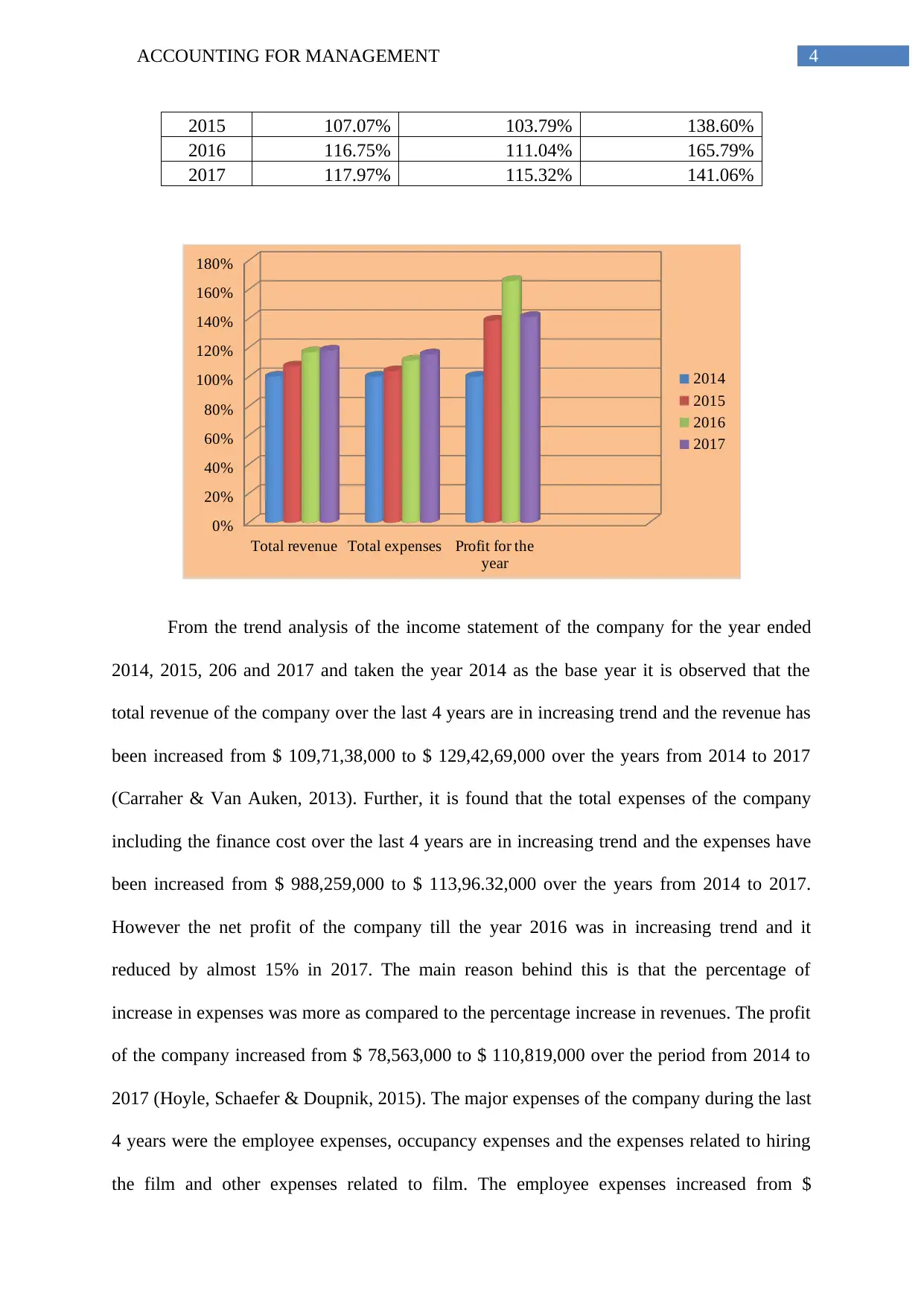
4ACCOUNTING FOR MANAGEMENT
2015 107.07% 103.79% 138.60%
2016 116.75% 111.04% 165.79%
2017 117.97% 115.32% 141.06%
Total revenue Total expenses Profit for the
year
0%
20%
40%
60%
80%
100%
120%
140%
160%
180%
2014
2015
2016
2017
From the trend analysis of the income statement of the company for the year ended
2014, 2015, 206 and 2017 and taken the year 2014 as the base year it is observed that the
total revenue of the company over the last 4 years are in increasing trend and the revenue has
been increased from $ 109,71,38,000 to $ 129,42,69,000 over the years from 2014 to 2017
(Carraher & Van Auken, 2013). Further, it is found that the total expenses of the company
including the finance cost over the last 4 years are in increasing trend and the expenses have
been increased from $ 988,259,000 to $ 113,96.32,000 over the years from 2014 to 2017.
However the net profit of the company till the year 2016 was in increasing trend and it
reduced by almost 15% in 2017. The main reason behind this is that the percentage of
increase in expenses was more as compared to the percentage increase in revenues. The profit
of the company increased from $ 78,563,000 to $ 110,819,000 over the period from 2014 to
2017 (Hoyle, Schaefer & Doupnik, 2015). The major expenses of the company during the last
4 years were the employee expenses, occupancy expenses and the expenses related to hiring
the film and other expenses related to film. The employee expenses increased from $
2015 107.07% 103.79% 138.60%
2016 116.75% 111.04% 165.79%
2017 117.97% 115.32% 141.06%
Total revenue Total expenses Profit for the
year
0%
20%
40%
60%
80%
100%
120%
140%
160%
180%
2014
2015
2016
2017
From the trend analysis of the income statement of the company for the year ended
2014, 2015, 206 and 2017 and taken the year 2014 as the base year it is observed that the
total revenue of the company over the last 4 years are in increasing trend and the revenue has
been increased from $ 109,71,38,000 to $ 129,42,69,000 over the years from 2014 to 2017
(Carraher & Van Auken, 2013). Further, it is found that the total expenses of the company
including the finance cost over the last 4 years are in increasing trend and the expenses have
been increased from $ 988,259,000 to $ 113,96.32,000 over the years from 2014 to 2017.
However the net profit of the company till the year 2016 was in increasing trend and it
reduced by almost 15% in 2017. The main reason behind this is that the percentage of
increase in expenses was more as compared to the percentage increase in revenues. The profit
of the company increased from $ 78,563,000 to $ 110,819,000 over the period from 2014 to
2017 (Hoyle, Schaefer & Doupnik, 2015). The major expenses of the company during the last
4 years were the employee expenses, occupancy expenses and the expenses related to hiring
the film and other expenses related to film. The employee expenses increased from $
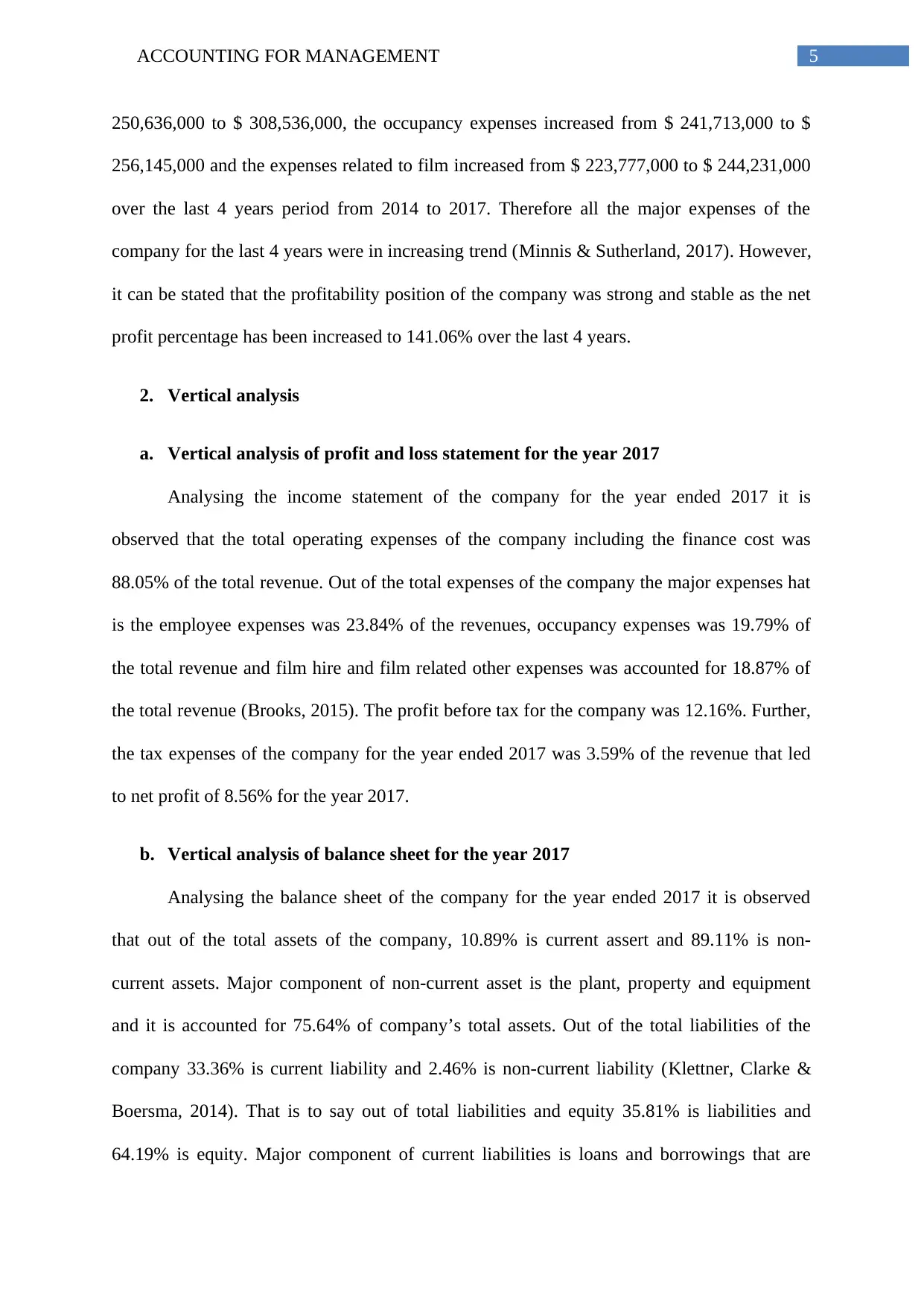
5ACCOUNTING FOR MANAGEMENT
250,636,000 to $ 308,536,000, the occupancy expenses increased from $ 241,713,000 to $
256,145,000 and the expenses related to film increased from $ 223,777,000 to $ 244,231,000
over the last 4 years period from 2014 to 2017. Therefore all the major expenses of the
company for the last 4 years were in increasing trend (Minnis & Sutherland, 2017). However,
it can be stated that the profitability position of the company was strong and stable as the net
profit percentage has been increased to 141.06% over the last 4 years.
2. Vertical analysis
a. Vertical analysis of profit and loss statement for the year 2017
Analysing the income statement of the company for the year ended 2017 it is
observed that the total operating expenses of the company including the finance cost was
88.05% of the total revenue. Out of the total expenses of the company the major expenses hat
is the employee expenses was 23.84% of the revenues, occupancy expenses was 19.79% of
the total revenue and film hire and film related other expenses was accounted for 18.87% of
the total revenue (Brooks, 2015). The profit before tax for the company was 12.16%. Further,
the tax expenses of the company for the year ended 2017 was 3.59% of the revenue that led
to net profit of 8.56% for the year 2017.
b. Vertical analysis of balance sheet for the year 2017
Analysing the balance sheet of the company for the year ended 2017 it is observed
that out of the total assets of the company, 10.89% is current assert and 89.11% is non-
current assets. Major component of non-current asset is the plant, property and equipment
and it is accounted for 75.64% of company’s total assets. Out of the total liabilities of the
company 33.36% is current liability and 2.46% is non-current liability (Klettner, Clarke &
Boersma, 2014). That is to say out of total liabilities and equity 35.81% is liabilities and
64.19% is equity. Major component of current liabilities is loans and borrowings that are
250,636,000 to $ 308,536,000, the occupancy expenses increased from $ 241,713,000 to $
256,145,000 and the expenses related to film increased from $ 223,777,000 to $ 244,231,000
over the last 4 years period from 2014 to 2017. Therefore all the major expenses of the
company for the last 4 years were in increasing trend (Minnis & Sutherland, 2017). However,
it can be stated that the profitability position of the company was strong and stable as the net
profit percentage has been increased to 141.06% over the last 4 years.
2. Vertical analysis
a. Vertical analysis of profit and loss statement for the year 2017
Analysing the income statement of the company for the year ended 2017 it is
observed that the total operating expenses of the company including the finance cost was
88.05% of the total revenue. Out of the total expenses of the company the major expenses hat
is the employee expenses was 23.84% of the revenues, occupancy expenses was 19.79% of
the total revenue and film hire and film related other expenses was accounted for 18.87% of
the total revenue (Brooks, 2015). The profit before tax for the company was 12.16%. Further,
the tax expenses of the company for the year ended 2017 was 3.59% of the revenue that led
to net profit of 8.56% for the year 2017.
b. Vertical analysis of balance sheet for the year 2017
Analysing the balance sheet of the company for the year ended 2017 it is observed
that out of the total assets of the company, 10.89% is current assert and 89.11% is non-
current assets. Major component of non-current asset is the plant, property and equipment
and it is accounted for 75.64% of company’s total assets. Out of the total liabilities of the
company 33.36% is current liability and 2.46% is non-current liability (Klettner, Clarke &
Boersma, 2014). That is to say out of total liabilities and equity 35.81% is liabilities and
64.19% is equity. Major component of current liabilities is loans and borrowings that are
⊘ This is a preview!⊘
Do you want full access?
Subscribe today to unlock all pages.

Trusted by 1+ million students worldwide
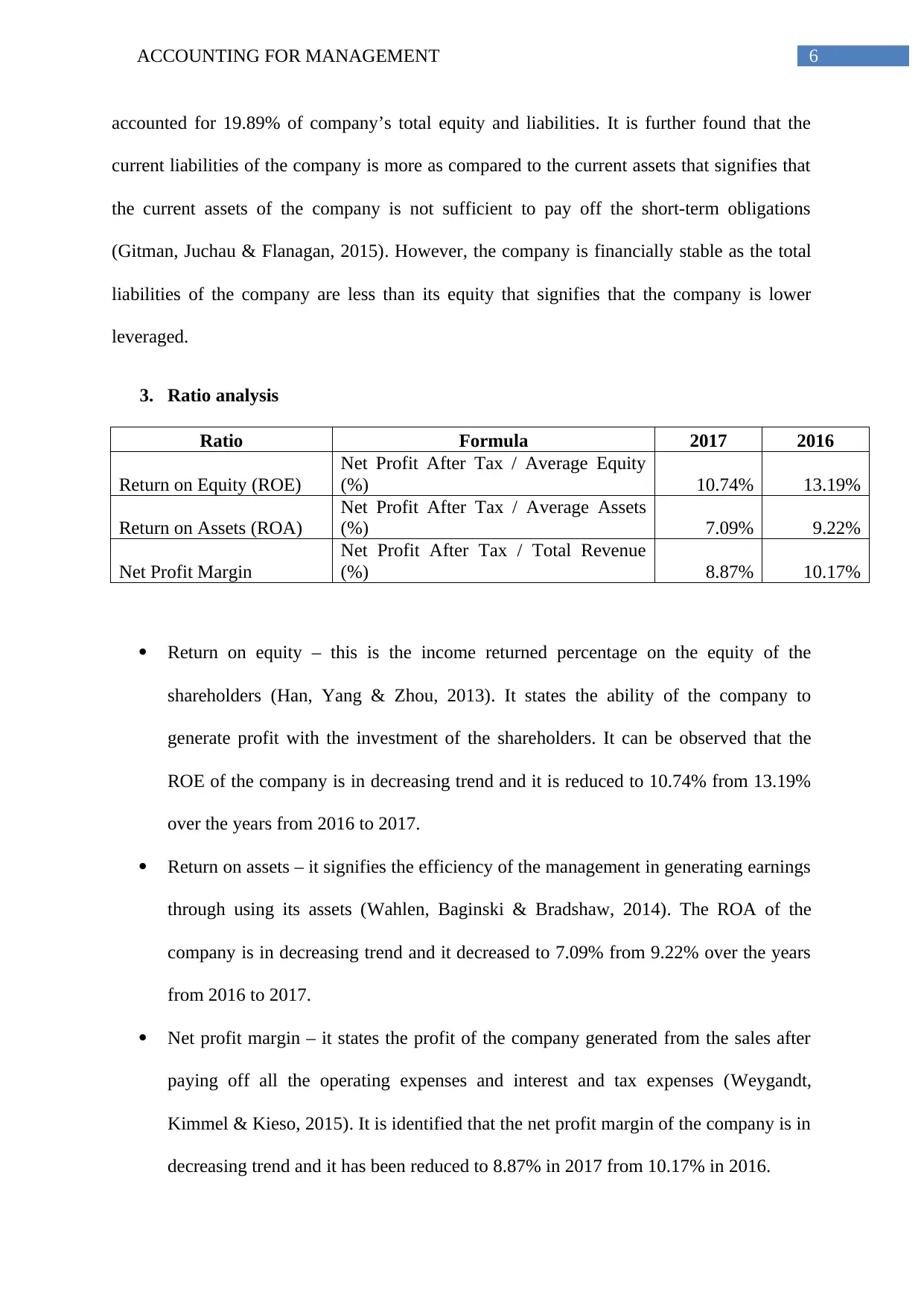
6ACCOUNTING FOR MANAGEMENT
accounted for 19.89% of company’s total equity and liabilities. It is further found that the
current liabilities of the company is more as compared to the current assets that signifies that
the current assets of the company is not sufficient to pay off the short-term obligations
(Gitman, Juchau & Flanagan, 2015). However, the company is financially stable as the total
liabilities of the company are less than its equity that signifies that the company is lower
leveraged.
3. Ratio analysis
Ratio Formula 2017 2016
Return on Equity (ROE)
Net Profit After Tax / Average Equity
(%) 10.74% 13.19%
Return on Assets (ROA)
Net Profit After Tax / Average Assets
(%) 7.09% 9.22%
Net Profit Margin
Net Profit After Tax / Total Revenue
(%) 8.87% 10.17%
Return on equity – this is the income returned percentage on the equity of the
shareholders (Han, Yang & Zhou, 2013). It states the ability of the company to
generate profit with the investment of the shareholders. It can be observed that the
ROE of the company is in decreasing trend and it is reduced to 10.74% from 13.19%
over the years from 2016 to 2017.
Return on assets – it signifies the efficiency of the management in generating earnings
through using its assets (Wahlen, Baginski & Bradshaw, 2014). The ROA of the
company is in decreasing trend and it decreased to 7.09% from 9.22% over the years
from 2016 to 2017.
Net profit margin – it states the profit of the company generated from the sales after
paying off all the operating expenses and interest and tax expenses (Weygandt,
Kimmel & Kieso, 2015). It is identified that the net profit margin of the company is in
decreasing trend and it has been reduced to 8.87% in 2017 from 10.17% in 2016.
accounted for 19.89% of company’s total equity and liabilities. It is further found that the
current liabilities of the company is more as compared to the current assets that signifies that
the current assets of the company is not sufficient to pay off the short-term obligations
(Gitman, Juchau & Flanagan, 2015). However, the company is financially stable as the total
liabilities of the company are less than its equity that signifies that the company is lower
leveraged.
3. Ratio analysis
Ratio Formula 2017 2016
Return on Equity (ROE)
Net Profit After Tax / Average Equity
(%) 10.74% 13.19%
Return on Assets (ROA)
Net Profit After Tax / Average Assets
(%) 7.09% 9.22%
Net Profit Margin
Net Profit After Tax / Total Revenue
(%) 8.87% 10.17%
Return on equity – this is the income returned percentage on the equity of the
shareholders (Han, Yang & Zhou, 2013). It states the ability of the company to
generate profit with the investment of the shareholders. It can be observed that the
ROE of the company is in decreasing trend and it is reduced to 10.74% from 13.19%
over the years from 2016 to 2017.
Return on assets – it signifies the efficiency of the management in generating earnings
through using its assets (Wahlen, Baginski & Bradshaw, 2014). The ROA of the
company is in decreasing trend and it decreased to 7.09% from 9.22% over the years
from 2016 to 2017.
Net profit margin – it states the profit of the company generated from the sales after
paying off all the operating expenses and interest and tax expenses (Weygandt,
Kimmel & Kieso, 2015). It is identified that the net profit margin of the company is in
decreasing trend and it has been reduced to 8.87% in 2017 from 10.17% in 2016.
Paraphrase This Document
Need a fresh take? Get an instant paraphrase of this document with our AI Paraphraser
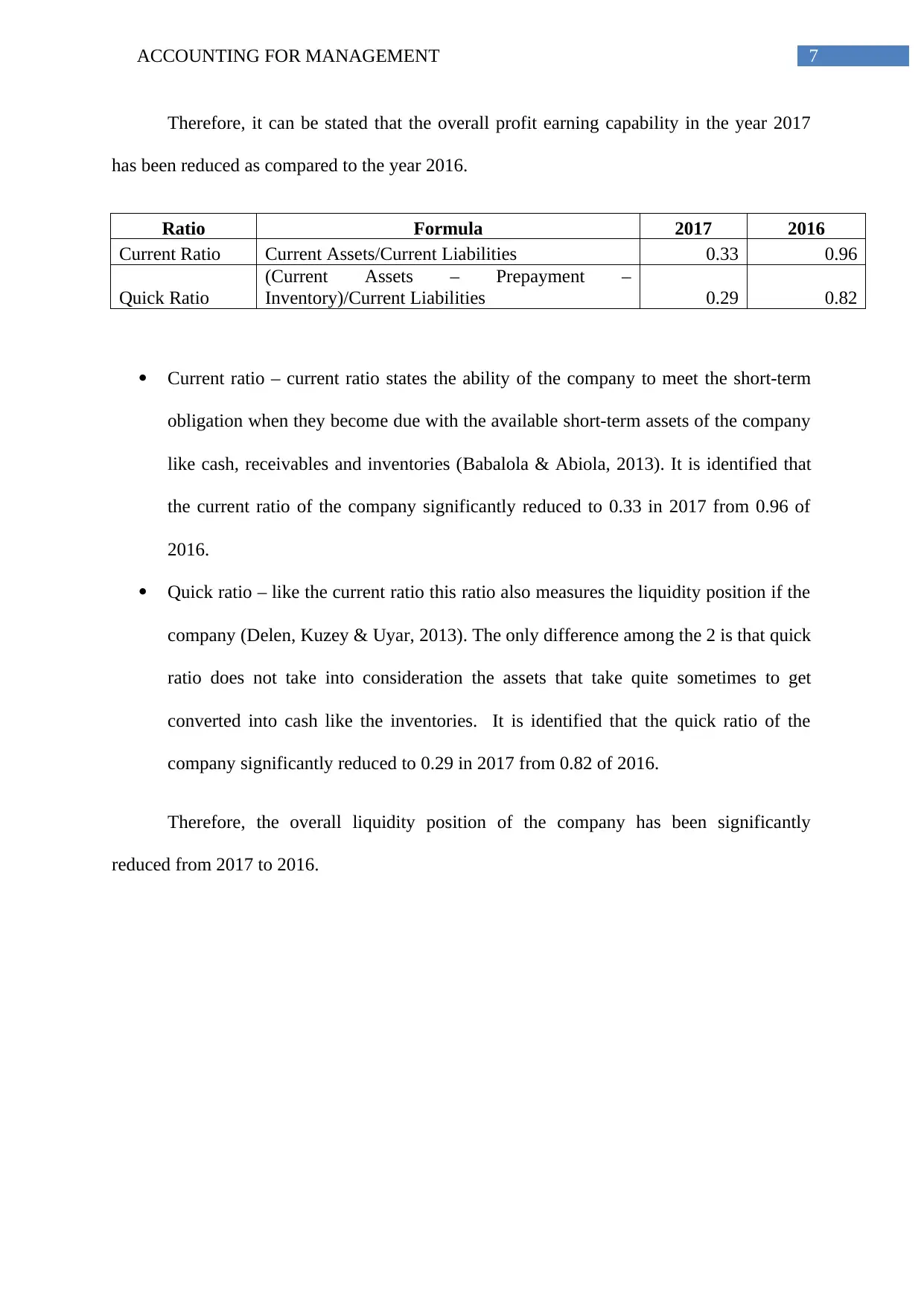
7ACCOUNTING FOR MANAGEMENT
Therefore, it can be stated that the overall profit earning capability in the year 2017
has been reduced as compared to the year 2016.
Ratio Formula 2017 2016
Current Ratio Current Assets/Current Liabilities 0.33 0.96
Quick Ratio
(Current Assets – Prepayment –
Inventory)/Current Liabilities 0.29 0.82
Current ratio – current ratio states the ability of the company to meet the short-term
obligation when they become due with the available short-term assets of the company
like cash, receivables and inventories (Babalola & Abiola, 2013). It is identified that
the current ratio of the company significantly reduced to 0.33 in 2017 from 0.96 of
2016.
Quick ratio – like the current ratio this ratio also measures the liquidity position if the
company (Delen, Kuzey & Uyar, 2013). The only difference among the 2 is that quick
ratio does not take into consideration the assets that take quite sometimes to get
converted into cash like the inventories. It is identified that the quick ratio of the
company significantly reduced to 0.29 in 2017 from 0.82 of 2016.
Therefore, the overall liquidity position of the company has been significantly
reduced from 2017 to 2016.
Therefore, it can be stated that the overall profit earning capability in the year 2017
has been reduced as compared to the year 2016.
Ratio Formula 2017 2016
Current Ratio Current Assets/Current Liabilities 0.33 0.96
Quick Ratio
(Current Assets – Prepayment –
Inventory)/Current Liabilities 0.29 0.82
Current ratio – current ratio states the ability of the company to meet the short-term
obligation when they become due with the available short-term assets of the company
like cash, receivables and inventories (Babalola & Abiola, 2013). It is identified that
the current ratio of the company significantly reduced to 0.33 in 2017 from 0.96 of
2016.
Quick ratio – like the current ratio this ratio also measures the liquidity position if the
company (Delen, Kuzey & Uyar, 2013). The only difference among the 2 is that quick
ratio does not take into consideration the assets that take quite sometimes to get
converted into cash like the inventories. It is identified that the quick ratio of the
company significantly reduced to 0.29 in 2017 from 0.82 of 2016.
Therefore, the overall liquidity position of the company has been significantly
reduced from 2017 to 2016.
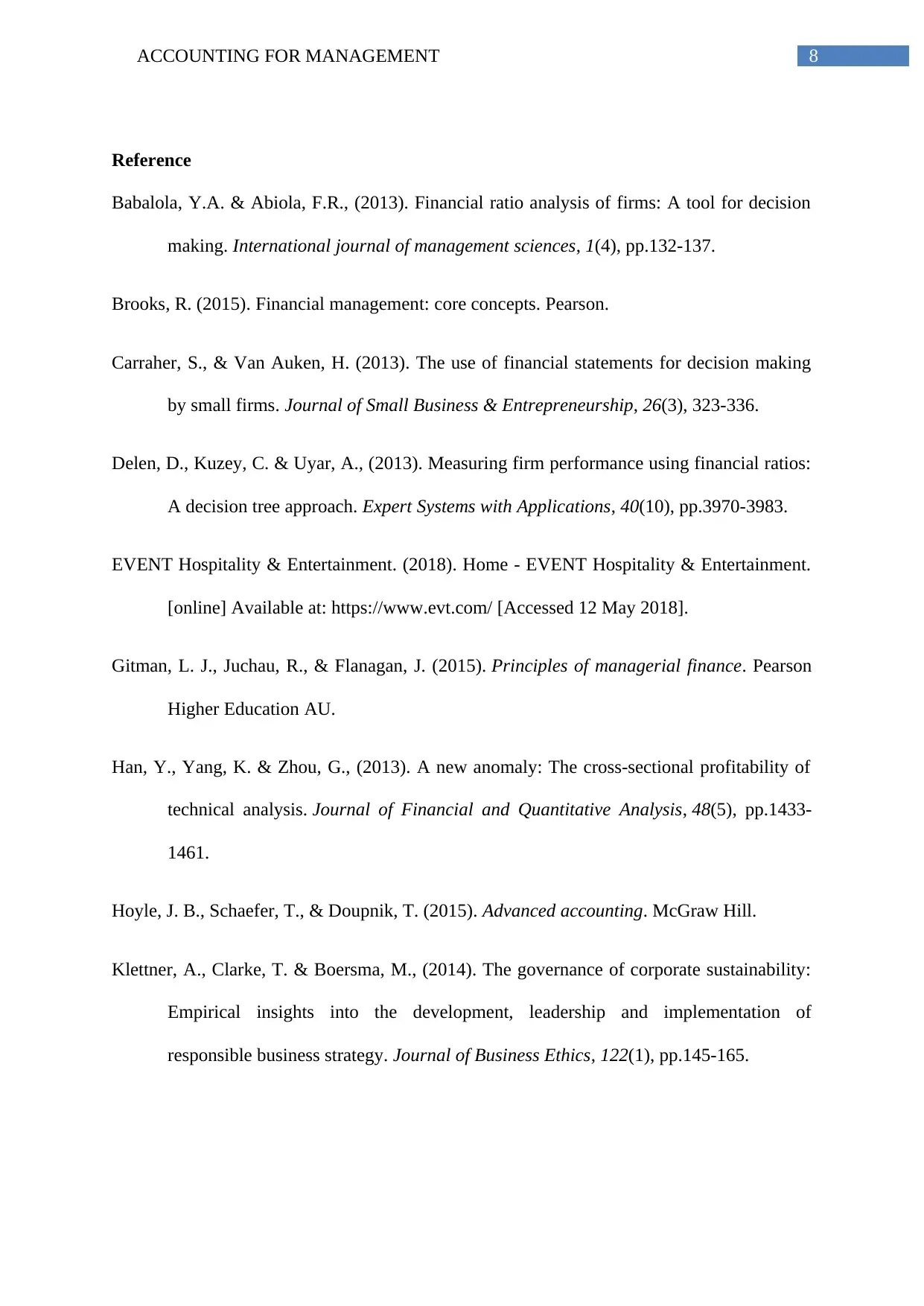
8ACCOUNTING FOR MANAGEMENT
Reference
Babalola, Y.A. & Abiola, F.R., (2013). Financial ratio analysis of firms: A tool for decision
making. International journal of management sciences, 1(4), pp.132-137.
Brooks, R. (2015). Financial management: core concepts. Pearson.
Carraher, S., & Van Auken, H. (2013). The use of financial statements for decision making
by small firms. Journal of Small Business & Entrepreneurship, 26(3), 323-336.
Delen, D., Kuzey, C. & Uyar, A., (2013). Measuring firm performance using financial ratios:
A decision tree approach. Expert Systems with Applications, 40(10), pp.3970-3983.
EVENT Hospitality & Entertainment. (2018). Home - EVENT Hospitality & Entertainment.
[online] Available at: https://www.evt.com/ [Accessed 12 May 2018].
Gitman, L. J., Juchau, R., & Flanagan, J. (2015). Principles of managerial finance. Pearson
Higher Education AU.
Han, Y., Yang, K. & Zhou, G., (2013). A new anomaly: The cross-sectional profitability of
technical analysis. Journal of Financial and Quantitative Analysis, 48(5), pp.1433-
1461.
Hoyle, J. B., Schaefer, T., & Doupnik, T. (2015). Advanced accounting. McGraw Hill.
Klettner, A., Clarke, T. & Boersma, M., (2014). The governance of corporate sustainability:
Empirical insights into the development, leadership and implementation of
responsible business strategy. Journal of Business Ethics, 122(1), pp.145-165.
Reference
Babalola, Y.A. & Abiola, F.R., (2013). Financial ratio analysis of firms: A tool for decision
making. International journal of management sciences, 1(4), pp.132-137.
Brooks, R. (2015). Financial management: core concepts. Pearson.
Carraher, S., & Van Auken, H. (2013). The use of financial statements for decision making
by small firms. Journal of Small Business & Entrepreneurship, 26(3), 323-336.
Delen, D., Kuzey, C. & Uyar, A., (2013). Measuring firm performance using financial ratios:
A decision tree approach. Expert Systems with Applications, 40(10), pp.3970-3983.
EVENT Hospitality & Entertainment. (2018). Home - EVENT Hospitality & Entertainment.
[online] Available at: https://www.evt.com/ [Accessed 12 May 2018].
Gitman, L. J., Juchau, R., & Flanagan, J. (2015). Principles of managerial finance. Pearson
Higher Education AU.
Han, Y., Yang, K. & Zhou, G., (2013). A new anomaly: The cross-sectional profitability of
technical analysis. Journal of Financial and Quantitative Analysis, 48(5), pp.1433-
1461.
Hoyle, J. B., Schaefer, T., & Doupnik, T. (2015). Advanced accounting. McGraw Hill.
Klettner, A., Clarke, T. & Boersma, M., (2014). The governance of corporate sustainability:
Empirical insights into the development, leadership and implementation of
responsible business strategy. Journal of Business Ethics, 122(1), pp.145-165.
⊘ This is a preview!⊘
Do you want full access?
Subscribe today to unlock all pages.

Trusted by 1+ million students worldwide
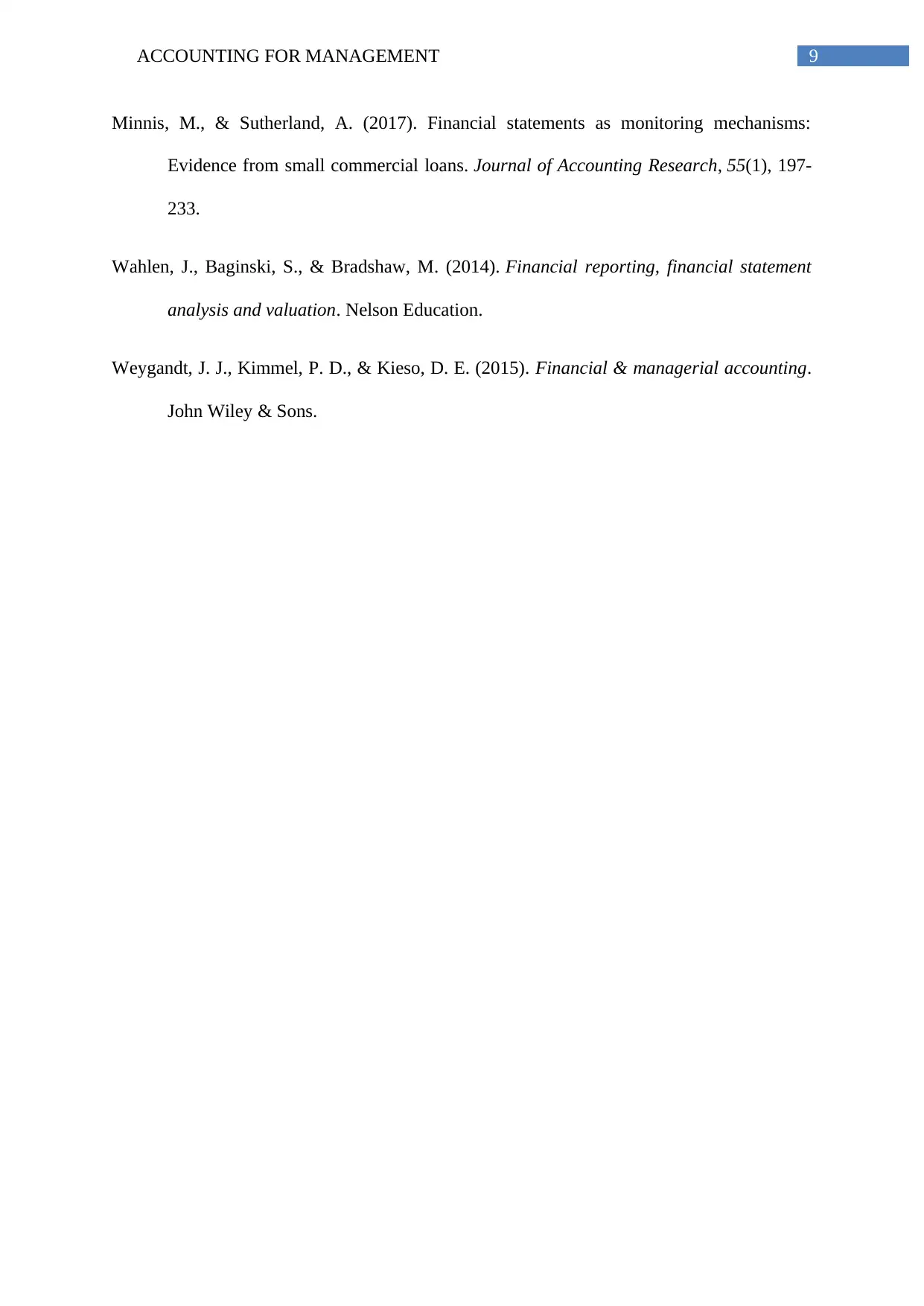
9ACCOUNTING FOR MANAGEMENT
Minnis, M., & Sutherland, A. (2017). Financial statements as monitoring mechanisms:
Evidence from small commercial loans. Journal of Accounting Research, 55(1), 197-
233.
Wahlen, J., Baginski, S., & Bradshaw, M. (2014). Financial reporting, financial statement
analysis and valuation. Nelson Education.
Weygandt, J. J., Kimmel, P. D., & Kieso, D. E. (2015). Financial & managerial accounting.
John Wiley & Sons.
Minnis, M., & Sutherland, A. (2017). Financial statements as monitoring mechanisms:
Evidence from small commercial loans. Journal of Accounting Research, 55(1), 197-
233.
Wahlen, J., Baginski, S., & Bradshaw, M. (2014). Financial reporting, financial statement
analysis and valuation. Nelson Education.
Weygandt, J. J., Kimmel, P. D., & Kieso, D. E. (2015). Financial & managerial accounting.
John Wiley & Sons.
1 out of 10
Related Documents
Your All-in-One AI-Powered Toolkit for Academic Success.
+13062052269
info@desklib.com
Available 24*7 on WhatsApp / Email
![[object Object]](/_next/static/media/star-bottom.7253800d.svg)
Unlock your academic potential
Copyright © 2020–2025 A2Z Services. All Rights Reserved. Developed and managed by ZUCOL.



